

Technical Reference – Intel® HTML5 App Porter Tool - BETA. , 2013.
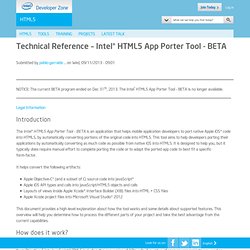
The Intel HTML5 App Porter Tool - BETA is no longer available. Legal Information Introduction The Intel® HTML5 App Porter Tool - BETA is an application that helps mobile application developers to port native Apple iOS* code into HTML5, by automatically converting portions of the original code into HTML5. How To Design A Mobile Game With HTML5. Advertisement Care to make a cross-platform mobile game with HTML5?
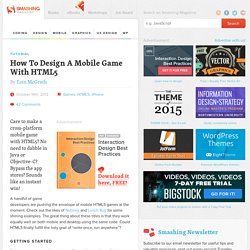
No need to dabble in Java or Objective-C? Bypass the app stores? Sounds like an instant win! A handful of game developers are pushing the envelope of mobile HTML5 games at the moment. Getting Started Before you start sketching the next Temple Run or Angry Birds, you should be aware of a few things that could dampen your excitement: Performance Mobile browsers are not traditionally known for their blazing JavaScript engines. Now, as a Web developer you’re used to dealing with the quirks of certain browsers and degrading gracefully and dealing with fragmented platforms. In this tutorial, we’ll make a relatively simple game that takes you through the basics and steers you away from pitfalls. It’s a fairly simple game, in which the user bursts floating bubbles before they reach the top of the screen.
Mozilla Developer Network. Learn how to create modern web apps using the latest web technologies and ideas — web apps that will have super powers in the latest modern browsers, but still provide an acceptable user experience in less able browsers.
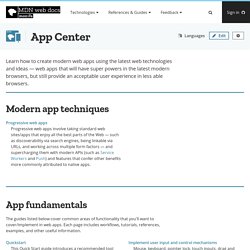
Modern app techniques Progressive web apps Progressive web apps involve taking standard web sites/apps that enjoy all the best parts of the Web — such as discoverability via search engines, being linkable via URLs, and working across multiple form factors — and supercharging them with modern APIs (such as Service Workers and Push) and features that confer other benefits more commonly attributed to native apps. App fundamentals The guides listed below cover common areas of functionality that you'll want to cover/implement in web apps. Quickstart This Quick Start guide introduces a recommended tool chain for creating web apps, and outlines the specific requirements for building Firefox OS applications.
Basic data flow. Parcours touristiques sur smartphones. TechDays 2011 : Dailymotion lance un lecteur HTML5 pour Windows Phone 7. Vous êtes ici : Accueil / Infrastructure / TechDays 2011 : Dailymotion lance un lecteur HTML5 pour Windows Phone 7 Le site de vidéo en ligne Dailymotion poursuit ses développements et diffuse dorénavant 26 chaînes internationales d’information.

Prochainement disponibles sur Windows Phone 7. Cocorico ! Le service de vidéo en ligne Dailymotion comble petit à petit l’écart le séparant de YouTube. Cette plate-forme vidéo est ainsi la seconde du marché et le 33e site mondial en terme de trafic. 90 millions d’utilisateurs uniques visitent ce site chaque mois. Dans le cadre des TechDays 2011, Éric Cremer, vice-président senior media development, a réaffirmé son soutien envers les technologies Microsoft.
Autre annonce, la compagnie s’est associé à Livestation pour diffuser les flux de 26 chaînes internationales d’information. Mobile Web API Evolution. Ragavan Srinivasan’s post about the forthcoming Mozilla Marketplace for Open Web Apps inspired me to write about Mozilla’s surging Web and Device API standards work.

A bit of background. Mozilla has always contributed to web standards, going back to the start of the project. We co-founded the WHAT-WG to kick off HTML5. As readers of this blog know, we are a leader in JS standardization. We have some of the top CSS and layout experts in the world. In the last eight months, our efforts to extend the web standards to include new APIs needed to build compelling apps and OS components on mobile devices have really caught fire.
The Screen Orientation API. Abstract The Screen Orientation API provides the ability to read the screen orientation state, to be informed when this state changes, and to be able to lock the screen orientation to a specific state.
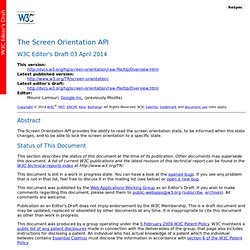
Status of This Document This section describes the status of this document at the time of its publication. Geolocation API Specification. Abstract This specification defines an API that provides scripted access to geographical location information associated with the hosting device.
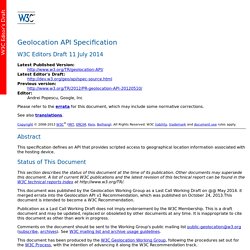
Status of This Document This section describes the status of this document at the time of its publication. Other documents may supersede this document. A list of current W3C publications and the latest revision of this technical report can be found in the W3C technical reports index at This document was published by the Geolocation Working Group as a Last Call Working Draft on @@ May 2014. it merged errata into the Geolocation API v1 Recommendation, which was published on October 24, 2013.This document is intended to become a W3C Recommendation. Publication as a Last Call Working Draft does not imply endorsement by the W3C Membership. Comments on the document should be sent to the Working Group's public mailing list public-geolocation@w3.org (subscribe, archives).
Table of Contents. Getusermedia: Getting access to local devices that can generate multimedia streams. 4.

MediaStream API 4.1 Introduction The MediaStream interface is used to represent streams of media data, typically (but not necessarily) of audio and/or video content, e.g. from a local camera. The data from a MediaStream object does not necessarily have a canonical binary form; for example, it could just be "the video currently coming from the user's video camera". This allows user agents to manipulate media streams in whatever fashion is most suitable on the user's platform. Each MediaStream object can contain zero or more tracks, in particular audio and video tracks.
B2G. Compare cross Mobile Dev. HTML5 based solutions. Firefox OS - Boot to Gecko (B2G)